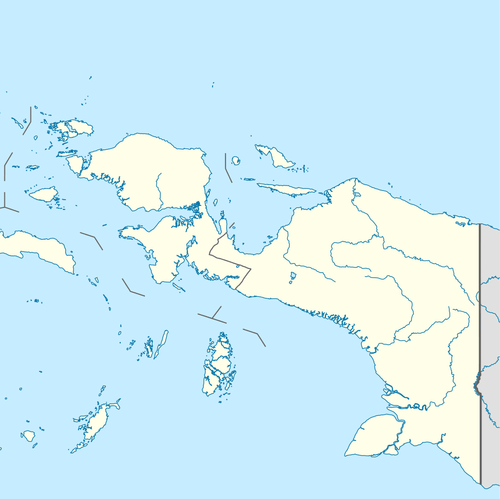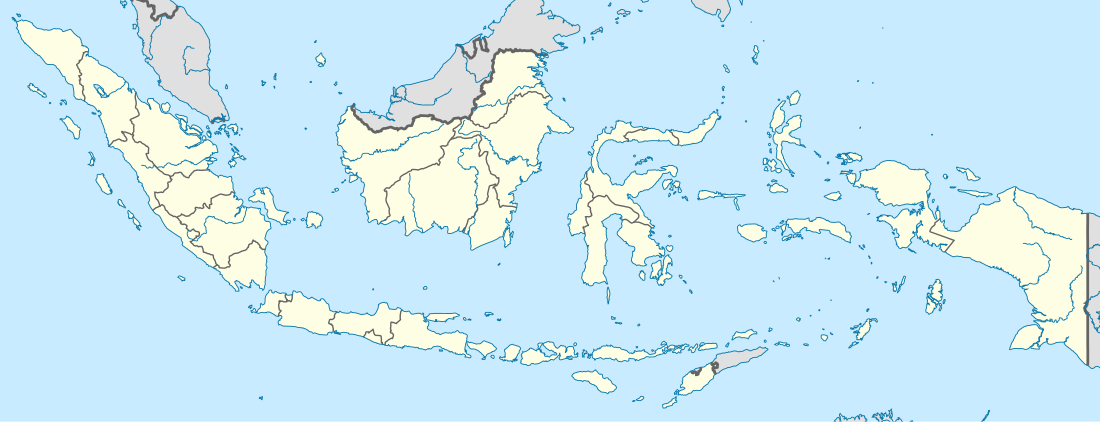Irarutu language
Irarutu, Irahutu, or Kasira, is an Austronesian language of most of the interior of the Bomberai Peninsula of north-western New Guinea in Teluk Bintuni Regency.[3] The name “Irarutu” comes from the language itself, where “ira” conjoins with “ru” to create “their voice”. When put together with “tu”, which on its own means “true”, the meaning of the name becomes “Their true voice” or “The people’s true language”.[4]
| Irarutu | |
|---|---|
| Irahutu | |
| Kasira | |
| Native to | Indonesia |
| Region | Bomberai Peninsula, in Teluk Bintuni Regency |
Native speakers | (4,000 cited 1987)[1] |
Austronesian
| |
| Language codes | |
| ISO 639-3 | irh |
| Glottolog | irar1238[2] |
 Irarutu  Irarutu  Irarutu | |
| Coordinates: 2.94°S 133.59°E | |
Kuri is very close lexically, but has not been formally classified. Other than this, Irarutu is quite divergent among the South Halmahera–West New Guinea languages. Irarutu is one of the many languages found in the South Halmahera subgroup of Austronesian languages.[3] There are seven variations found within the language: Nabi, Babo, Kasuri, Fruata, South-Arguni, East-Arguni, North-Arguni.[3]
Phonology
Consonants
Tyron (1995) gives the following consonants:[3]
| Bilabial | Dental/Alvelar | Palatal | Velar | Laryngeal | |
|---|---|---|---|---|---|
| Stops | p
b |
t
d |
c
ɟ |
k
g |
|
| Fricatives | f | s | h | ||
| Nasals | m | n | |||
| Flaps | r | ||||
| Semivowels | w | y |
/p, t, c, k, b, d, ɟ, g, are all stops with /p, t, c, k/ being voiceless and /b, d, ɟ, g,/ being voiced. All stop consonants can be placed in any position (beginning, middle, or end) with the exception of /c/ which cannot be placed in the ending position.[4]
/f, s, h/ are all voiceless fricatives. /f/ is found in all 3 positions and is sometimes pronounced as a voiced [v] by Native Irarutu speakers. /s/ is also found in all 3 positions but is never voiced. /h/ may be a recent addition to the language. /h/ is only found in initial and middle positions.[4]
/m, n/ are both voiced nasals. Both consonants are found in all 3 positions.[4]
/r/ is found in most Irarutu dialects, but is sometimes switched out with [l].[4]
Vowels
Tyron (1995) gives the following vowels:[3]
| Front | Central | Back | |
|---|---|---|---|
| High | i
ɪ |
y | u |
| Mid | e | o | |
| Low | a |
7 types of vowels are found in Irarutu, /a, e, ɪ, i, o, u, y/. The vowels can then be formed in two different ways, one being monophthongs and the other being diphthongs. Monophthongs are a single sounding vowel while diphthongs are a combination of two separate vowels. All 7 vowels can be used in monophthong form but diphthong is restricted to only a few combinations.[4]
Grammar
Irarutu follows the "Subject, Verb, Object" (SVO) format in word order. Adjectives such as "big" or a numbered value come after the noun, but for lineage-related matters the initial ancestor comes before the descendant.[3][4]
Nouns
Nouns are words that can be placed in the “Subject” or “Object” portions of a sentence and can be modified for possessive relations. There are 3 functions of noun phrases: semantic function, pragmatic function, and grammatical function. In Irarutu, the grammatical function for nouns and pronouns do not differ for unique situations.[4]
Possessive noun phrase
For possessive noun phrase there are usually no prefixes, suffixes, or any other alterations made to the noun of interest. The only cases where changes to the word are made are for body parts, names, and one's child.[3]
Verbs
Both transitive and intransitive verbs are found in the Irarutu language. These verbs are conjoined with prefixed marks to show who is creating/causing the action. Up to three unique individuals can be indicated using these marks. Sounds within the verb can change if the verb stem begins with "t, ɪ, b, m, or s.[3]
Verb function
There are three different types of prefixes relating the person who is creating the action. “a-“ refers to 1st person, “m-“ for 2nd and “n-“ for 3rd. “a-“ is used for 1st person cases but holds many rules along with it. “m-“ is seen in almost all cases for a 2nd person sentence and is sometimes accompanied by an inflection. “n-“ is present with a verb root in 3rd person and also tends to use inflection in the prefix.[4]
Adjectives
Adjectives can be used to alter nouns or clauses and in most cases come after the statement it is altering. In Irarutu there is also a subclass of adjectives that differentiate the level of magnitude on which the adjective affects the subject/object. There are both clause-level and phrase-level adjectives, each of which affects the topic at hand differently. Nouns with multiple adjectives are indeed possible, but a bit uncommon. Adverbs exist but are often hard to point out in Irarutu sentence structure. Sometimes an entire phrase will be used to modify a verb or adjective. To make the meaning of a sentence clear, specific verbs, which can only be modified by certain adverbs, are used to show what part of the sentence is modifying what. The sequence and placement of the adverb also helps identify which part of the claim it is modifying.[4]
References
- Irarutu at Ethnologue (18th ed., 2015)
- Hammarström, Harald; Forkel, Robert; Haspelmath, Martin, eds. (2017). "Irarutu". Glottolog 3.0. Jena, Germany: Max Planck Institute for the Science of Human History.
- Tyron, Darrell T., ed. (1995). Comparative Austronesian Dictionary An Introduction to Austronesian Studies Part 1. Trends in Linguistics Documentation 10. Mouten de Gruyter. p. 638. ISBN 3111797082.
- Jackson 2014, pp. 7, 43, 44, 52
Bibliography
- Jackson, Jason Alexander Johann (2014). A Grammar of Irarutu, A language of West Papua, Indonesia, With Historical Analysis (Ph.D. thesis). University of Hawaii at Manoa. hdl:10125/100426.CS1 maint: ref=harv (link)
- Voorhoeve, Clemens L. (1989), "Notes on Irarutu (an Austronesian language spoken in the centre of the Bomberai Peninsula, Southwest Irian Jaya)" (PDF), IRIAN, 17: 107–119, archived from the original (PDF) on 2006-08-18CS1 maint: ref=harv (link)